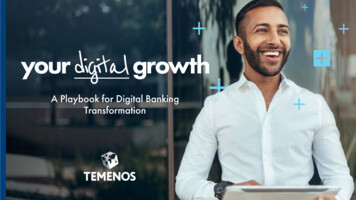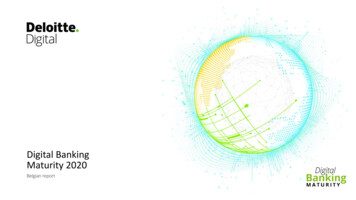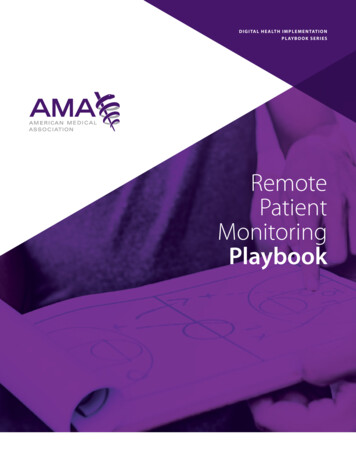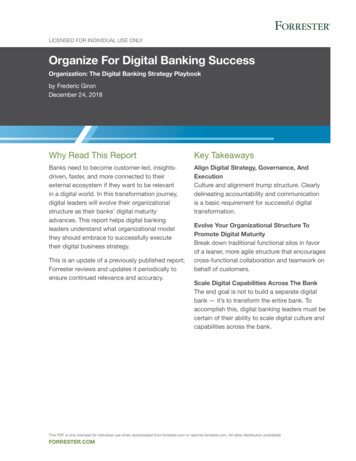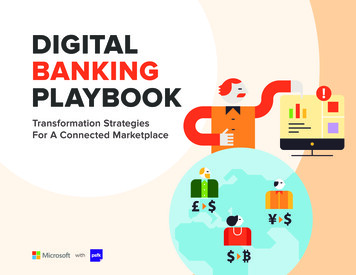
Transcription
DIGITALBANKINGPLAYBOOKTransformation StrategiesFor A Connected Marketplacewith
Introducing TheDigital Banking FrontierThe primary duty of any financial community is toproduce, empower and actualize opportunity. Fromproviding loans to jumpstarting entrepreneurial ventures,banks can provide an arsenal of catalytic tools forbusinesses and individuals alike to achieve their goals.This economic importance has forced banks to rely on decades ofestablished structures comprised of strictly defined roles—and in apre-digital world, it’s worked. However, in an economy of constrainingregulations, heightened competition and elevated customer demands,it’s these legacy systems and siloed operations that are preventinggrowth and stalling innovation.To find success in this new landscape, financial organizations will needto look to emerging technologies, like artificial intelligence and machinelearning software, to deliver more relevant services in the midst ofchanging markets. Banks with a digital infrastructure at the core canquickly adapt to changes in the marketplace and provide differentiatedcustomer experiences, effectively establishing themselves as trustedand confident brokers for their clients’ and organization’s needs.The keys for actualizing a successful digital business transformationrevolve around four key pillars:1. Engage clients with differentiated experiences that tailor to theirpersonal financial needs and goals2. Empower employees with tools that can provide accessible, holisticinformation at their fingertips about individual clients, while meetingcritical security and compliance needs3. Optimize internal operations with synchronized processes anddemocratized data-sharing4. Transform products with open and connected systems and real-timepredictive digital processesThe influence of technological, cultural and regulatory requirementsmandate accelerated change across financial services.Likewise, the opportunities presentedwith digital transformation extend to allbanking verticals—from retail banking tocapital markets. Because these shifts havedecentralized banking operations, an agile, digital ecosystem is necessaryfor institutions to have greater, data-driven intelligence on their customers,markets and internal business processes.In the Digital Banking Playbook, PSFK highlights how digital toolscan augment a financial institution’s ability to optimize operations andreinvigorate the client experience. Backed by marketplace trends andstrategies for successful implementation, we present three scenarios thatground this digital conquest within the contextual framework of today’sbanking operations. This digital vision presents a new opportunity todeliver unprecedented innovation to the customer, as well as the internal,overarching banking enterprise.Piers FawkesFounder & Editor-in-ChiefPSFKABOUT THIS REPORTThe Digital Banking Playbook is a report by business intelligenceplatform PSFK in partnership with Microsoft that presentsopportunities for driving financial institutions forward with anintelligent cloud. Three scenarios highlight how cloud-based solutionscan help the industry minimize risk, ensure optimal service at scaleand think differently about security, privacy and regulatory compliance.Backed by expert insights and key analyses of global industry trends,the Digital Banking Playbook will guide financial institutions of all sizesas they aim to service a broader range of global clientele.For copies: psfk.com/digital-banking-playbookDigital Banking Playbook2
Financial ServicesIndustry DisruptorsSPEED OF THEMARKETPLACEPERSONALIZATIONEXPECTATIONRISE OF ALTERNATIVEBANKING SOLUTIONSAccelerated market speeds areplacing increased pressure onfinancial institutions to rapidlyrespond to marketplace changes.The ability to analyze data inreal time and accurately forecastoutcomes, alongside havingthe right internal structures inplace to quickly act, is becomingimperative for organizations toremain competitive.The digital transformation of otherindustries—retail, hospitality,entertainment—is giving rise tomass customization at scale,creating an expectation forproducts, services and experiencestailored to a market size of one.Slow innovation by traditionalfinancial players has createdopportunities for nimble startupswith digital DNA at their core toenter the marketplace. While manylack the scale of incumbents, acompelling mix of personalization,transparency and flexibility havepositioned these companiesas appealing alternatives totraditional financial institutions.INCREASED DATABREACH RISKAs growth in the number ofdigital transactions continuesand banking infrastructuresmigrate to a broader range ofplatforms, financial institutions,their employees and clientsface increased exposure to databreaches. Additionally, banks havepaid 280 billion dollars in finessince 2009, indicating an elevatedneed for expanded, holisticsecurity measures.BALANCINGINNOVATION ANDREGULATIONHeavy compliance issues andregulations imposed on financialinstitutions are obstacles to thepace of technology innovationenjoyed by other industries.Because banks have too highcost-income-ratios, they needto optimize cost in order todrive innovation. Organizationsmust learn to navigate thesecomplexities and positionthemselves as category leadersto drive meaningful change.Digital Banking Playbook3
Understanding TheDigital Disruption:RetailBankingKEY CHALLENGES Building trust with customerswho demand transparencyand enabling two-wayconversation channels Reversing the declinein customer loyaltyand engagement Creating platforms andservices that cater to customerexpectation for personalization,security and convenience Developing innovationand cross-channel efficiencyat scale within a legacysystem environment Adapting to regulationand compliance costs whichinhibit agilityTo bring value back to their own platforms, banks mustoffer seamless, contextual customer experiences acrossall channels. By reimagining the customer narrativethrough a digital lens and delivering secure, omni-channelaccess, banks can deliver highly personal, differentiatedservices and cultivate trust.SUPPORTING INSIGHTS Synchronizing customerexperience across multiplechannels—online, mobileand physical branches Ensuring secure and seamlessdigital transactions andprotecting customers fromfraudulent activityThe ‘bundled’ and less transparent products of traditionalbanking institutions are proving inefficient for a new waveof informed and always-on customers. Fintech firms, bycontrast, are leveraging cutting-edge digital solutions toappeal to consumers—offering hyper-relevant productsand services, seamless, multi-channel access and opentransparency about fees and operations. Managing costs associated withcustomer acquisition and newproduct development Extracting additional valuethrough personalized productsand services Evolving traditional legacysystems, company cultureand processes50.2%20%Capgemini And LinkedIn WFTR VoiceOf The Customer Survey. CapgeminiFinancial Services Analysis, 2016Efma Review: 2017. Efma, 2017of global consumersdo business with atleast one non-traditional banking firm.11%of consumers left theirbank in the past year—andconsumers switching to virtual banksis at double-digit levels.2016 North America ConsumerDigital Banking Survey.Accenture Consulting, 2016“Banks can’t choose betweendigital and physical retail channels;rather, they must focus on how thetwo work together.”of financial institutionsare now launchingor considering launching a digitalbank as a parallel bank to theexisting operation.“Banks and credit unions of all sizesare not prepared to combat theincreasing encroachment by fintechstartups that focus on making everystage of the customer journey easy,seamless and contextual.”“Why Fintech Firms Are Winning TheBattle For Digital Consumers.”The Financial Brand, 2016Jim Miller. Senior Director of Banking,J.D. PowerDigital Banking Playbook4
Innovation Strategies For Retail BankingDEVELOPCONVERSATIONALINTERFACESFinancial institutions can deploydigital assistants to conveycrucial financial information innatural, conversational languageto consumers who need quickresolutions to common problemsor requests. These services, oftenintegrated into existing digitalplatforms, help customers makefinancial decisions in less time andare able to adapt to their real-timecontextual needs. Conversationaltools can also solve menialcustomer requests and liberatehuman counterparts to take on amore personalized, active role totheir customer service.ENABLE OMNICHANNELPAYMENT EXPERIENCESCustomers are seekingcross-channel access to theirfinances based on their uniquepreferences or circumstantialconditions. To empower customersto choose their preferred channel,banks can use APIs to integratefinancial tools into partneringplatforms, which allow users tocomplete a payment experiencewithout leaving a provider or losingdata. Untethered and unrestrictedengagement allows increasedcustomer satisfaction and positionsthe bank as a lifestyle partner.OFFER HOLISTICCREDIT EVALUATIONAI-enabled tools and servicescan help banks provide a morebehavioral-based assessment ofthe creditworthiness of potentialcustomers. By augmentingtraditional credit evaluationmethodologies with additionalindicators of reliability, financialadvisors can grow the list ofcustomers they are able to serve.While AI-assistants can forgepredictive and preventativesolutions for instant creditscoring services, clients canreceive tailored service andrecommended products fromhuman banking associates.PROVIDE BIOMETRICAUTHENTICATIONWith today’s uninhibited,always-accessible digitization,a complex password or securitycode doesn’t always ensureoptimal security. To betterprotect investments and financialportfolios, banking institutionsare employing security featuresthat leverage personal biometriccharacteristics to authenticateaccess to financial information.Financial systems are verifyingcustomer identity through voiceactivation, fingerprints and othervisual cues to provide bettersecurity measures, with an addedconvenience for the consumer.CREATE ANOPERATIONALECOSYSTEMAs consumers grow morecomfortable with ambienttechnologies within their homes,automobiles and daily routines,banks must partner withthird-parties to integratefinancial processes, services,content and data into theconsumer ecosystem in a secureand reliable way. By assuminga role in a user’s connectedroutine, a financial institution cansecurely communicate and learnfrom consumers in their mostnatural environments.DELIVER PROGRESSIVETRANSPARENCYFinancial services can buildtrust and gain consumer loyaltyby inviting consumers to take alook at their internal operationalstructures and fee litigation. Byusing clearer messaging, visiblefee structures and even allowingcustomer input into product andservice development, customerswill feel more comfortable relyingon a bank to handle all theirfinancial needs.Digital Banking Playbook5
Quick Win InitiativesCUSTOMER EXPERIENCESECURITY Gain actionable customer insights to enable higher-valueclient relationships and personalized banking experiences.Deepen your understanding of each customer by trackingthe details of every interaction—whether in person or viaphone, web, mobile, email or social media—to delivercontextual, connected experiences Determine what points of the retail banking process, fromcash withdrawal to transaction authentication, are themost vulnerable for security flaws and fortify them withenterprise-grade encryption and biometrics Customize experiences with personalized financialguidance, service, and offers. Increase customersatisfaction and improve upsell and cross-sell performanceby engaging customers with personalized financialguidance and next best offers Leverage AI assistants to detect, compile andaggregate patterns of suspicious behavior that couldindicate financial fraud Build consumer trust by proactively educating clients in bestpractices to protect themselves from security breaches, whilecommunicating your security initiatives Democratize artificial intelligence and make it valuable toeveryone. Benefit from built-in intelligence, based on deeplearning technology, with solutions that see, hear, speak,and understand customer needs and emotions using naturalmethods of communicationRISK MANAGEMENT Develop tools and content that help customers understandthe components that determine their risk profile; buildclient trust by offering transparent risk assessments andrecommendations to improve creditworthiness Leverage AI to explore alternate indicators ofcreditworthiness like purchase behavior, social media activity,job history and other components of personal data to supporta more holistic risk assessment Use cloud technologies to reduce the time needed to gatherapproval for loans and reduce processing time, reducingtotal cost and enabling banks to reach a broader range ofpotential consumersMICROSOFT SPOTLIGHT:INNOVATION IN ACTIONUK-based retail bank Metro Bank partnered with Microsoft tofully optimize their customer service delivery. By leveragingMicrosoft Dynamics 365 platform, Metro Bank’s employees areempowered to answer their customers’ needs with easy accessto information. Because Metro Bank’s goal is to provide optimalcustomer convenience and omnichannel access, they also useDynamics 365 to streamline customer interaction. Additionally,Power BI allows employees to identify and address problemsbefore they interfere with the customer experience. By makingMicrosoft solutions an integral part of its employee operations,Metro Bank is transforming the customer experience.bit.ly/2uvy5wbDigital Banking Playbook6
Scenario: Fluid Consumer BankingINSIGHTMobile-first, global lifestyles and uncertainty towardsfinancial institutions are causing consumers to seekalternatives to traditional banks. To change the relationshipthey have with their customers, banks are evolving to delivergreater transparency and offer services that align withcurrent consumer behaviors and needs.Mary currently uses a larger bank but wants to switchto a digital-only bank to have greater access to herfinancial assets. This new bank would allow Mary toaccess financial services through a range of platforms,partners with frequently used commercial services andprioritizes transparent communication at every step.1Mary submits an application to the digital-only bank. She isapproved based on her employment history, patterns of transactionsand social media activity.2While shopping, Mary decides on a dress to purchase and ispresented with a bill. Because Mary’s bank analyzes her purchasepatterns, they recognize that this transaction is atypical for her andalert her via a mobile app.3Mary is able to authorize the transaction through her bank byscanning her fingerprint.Digital Banking Playbook7
4Afterwards, Mary goes out to dinner. Sherealizes that she forgot to transfer money toher daughter Patricia, who is doing a semesterabroad in the UK.5She uses Facebook Messenger to ask her bankto initiate the transfer.6The bank’s AI chatbot responds and asks Maryto authenticate her identity by sending a selfie.7Once Mary sends a selfie, the AI chatbotapproves the transaction.8Mary asks for a check when she finishes dinner. The waiter sends thecheck to her phone and she approves the charge by scanning herfingerprint. The waiter receives a notification that the bill has been paid.9While driving home, Mary’s AI assistant, which is integrated into the carsystem, reminds her of upcoming bill payments; she requests to pay themfrom her car. The in-vehicle AI assistant verifies her identity via her voiceand the bank verifies her payment.10At the end of the day, Mary is able to access a summary of the day’stransactions on her desktop, mobile devices and at-home voice assistants.Digital Banking Playbook8
Understanding TheDigital Disruption:InvestmentBankingKEY CHALLENGESTo improve operational efficiency and risk managementcapabilities, investment banks are moving to cloudbased solutions. In doing so, they can derive moresophisticated data insights, streamline operationalefficiencies and improve security, while designing withagility-first, new business models.“ Addressing structural costby creating an agileinfrastructure that can respondto evolving market trends andregulatory requirements Improving the efficiencyand speed of collaborationbetween bankers acrossdepartments to employ theexpertise of colleagues Optimizing compute capacitybased on real-time needs andusage to ensure proficiencyof risk models Increasing bankers’ mobilityresources for remote, secure,private and compliant accessto their working platforms Upgrading legacy systemsto more effectively gather,analyze and contextualizea wide range of data Quickly deploying new,innovative products andservices to deliver morevalue to clients Scaling computing resources tooptimize risk management andmeet a continued evolution ofregulatory requirementsWith extremely high regulatory scrutiny and increasingcomplexity in managing risk, it is an unprecedentedtime for the financial industry. The industry alsocontinues to face margin pressures, while requirementsfor increased capital reserves and liquidity are centralto a bank’s freedom to fund new market opportunities.60%Capital Marketsinstitutions say thatcloud-based entrants will challengetraditional industry models.”“Top 10 Challenges For InvestmentBanks.” Accenture, 2017.“Capital markets and investmentbanking firms invested heavily indigitizing their front offices years agobecause there was a commercialimperative to do so. While ROEswere high, there was less of animmediate need to innovate in theback office. That is no longer thecase. The business model is changing,and we have to find new ways toreduce structural costs and simplifyour architecture. We have to innovate,and we are engaging our people atevery level in the organization in theinnovation agenda.”“Our industry is going througha transformational time, drivenby competition, regulation andadvancements in technology.”Daniel Pinto. CEO of the Corporate &Investment Bank, J.P. MorganSource: EY-Capital Markets-Innovation“We are at a point where we have anopportunity to reposition financialservices. With the technologyavailable, we can change the waytransactions are done, reducingcosts from dollars to pennies.Through collaboration, we have theopportunity not only to revivebusinesses that have died, but alsoto create new ones that haven’t evenbeen thought of.”David Rutter. Founder and CEO,R3 CEVSource: EY-Capital Markets-InnovationAnthony Woolley, UK Chief InformationOfficer, Société GénéraleSource: EY-Capital Markets-InnovationDigital Banking Playbook9
Innovation Strategies ForInvestment BankingCREATE PERSONALIZEDEXPERIENCESAT SPEEDWith ever-increasing marketspeeds, the ability to predictthe efficacy of an investmentbecomes more difficult. Byleveraging artificial intelligenceand data farming tools, financialinstitutions can more quicklyidentify risks associated withtrades or investment opportunities.These systems analyze patternsin local contexts, global policiesand other market fluctuations toprovide a thorough analysis of therisks associated with investmentdecisions, assess trade values ormake the trades on their own, allat the speed of the market.ENABLE A MODERNWORKPLACEBy providing a modern workplace,firms can ensure that staff arealways able to access secureinformation and contribute to inthe-moment analyses. Internally,employees are able to collaborateand make better-informeddecisions that are based on realtime data, increasing accuracy andexpediting processes. Intelligentvirtual assistants can automatetedious and time-consuming tasks,allowing bankers to concentrateon servicing client relationships.OPTIMIZING RISKMANAGEMENT& COMPLIANCETo expedite compliancepreparation and regulatoryrequirements when underwritingmergers, acquisitions and tradingportfolios, regulatory teams canincorporate cloud-enabled toolsinto their existing systems torun risk models, complete stresstesting and ensure compliance.Technology such as blockchainprovides a secure way to exchangeinformation between multipleparticipants that need to approvedeals and transactions, savingtime and streamlining processesto reduce operational costs.EMBRACE THEAPI ECONOMYIn order to survive in today’srapidly changing financialmarkets, bankers needto focus on product andservice innovation—at amacro, enterprise-wide scale.Although traditional financialinstitutions have been siloedand self-sufficient, bankersmust collaborate with thirdparty technology developers tocompete and expand serviceofferings. By embracing anopen financial ecosystem, theycan unlock new investmentopportunities for their clientsand drive growth.Digital Banking Playbook10
Quick Win InitiativesCLIENT CENTRICITYREGULATORY COMPLIANCE Provide personalized experiences by transformingcustomer data into next-best actions, ensuring long-termclient relationships Migrate computational systems to the cloud to protectclient, transaction and institutional data Put the client at the heart of everything with a360-degree view of their needsBANKER PRODUCTIVITY Analyze current internal data-sharing systems anddetermine which steps are most vulnerable to threats;compartmentalize these areas to create an infrastructurethat responds more quickly without compromising theentire operation Reduce the compliance burden by analyzing internaland market data on an ongoing basis, in order to identifyfraud patterns and offer enhanced security throughreal-time fraud analytics Offload preliminary research and modeling responsibilitiesto machine learning technologies to reduce computationaltimes and better use staff time Build a mobile workforce by offering employees secureaccess to real-time information from any device Encourage inter-departmental collaboration via cloudbased workstream platforms, which share up-to-the-minuteinformation and updates to expedite documentpreparation, compliance review and regulatory approvalADVANCED RISK ANALYTICS Invest in cloud-based risk compute capacity to improvemodeling accuracy and evaluate risk more efficiently Create omnipresent, simplified dashboards that helpteams monitor risk exposure in real time and incorporaterisk analytics as part of their everyday activitiesMICROSOFT SPOTLIGHT:INNOVATION IN ACTIONMitsubishi UFJ Securities International plc, a member ofMUFG, a global financial group, is committed to serving itsclients best-in-class financial solutions, while adhering tothe high standards needed to support the new regulatorylandscape. In order to house the volume of data needed tocompute its risk calculations, MUFG moved its on-premises,high-performance computing grids to Microsoft Azure. Byoffloading its daily risk assessments to Azure, MUFG canensure agile risk computations at scale, while optimizingsecurity for both its firm and client data.bit.ly/2wxI19CDigital Banking Playbook11
Scenario: Managing InvestmentsAgainst Unexpected Market EventsINSIGHTBy leveraging deep data insights and AI-powered advisory tools, bankscan provide faster, more intelligent advice and execution capabilitiesto their clients. These intelligent digital tools improve accessibilityfor sophisticated investment management to allow users to deal withunexpected and volatile market events swiftly and effectively.Karen is an ultra high net worth clienttraveling from London to New York.1Karen, who holds investments in Japan’s energy sector, receives analert on her mobile device from her bank’s AI-powered investmentbot that Japan has issued a tsunami warning after detecting offshoreseismic activity.2The bot sends Karen a detailed summary of the situation andrisk, loss and effect imposed.3The virtual bot automates a risk simulation of possible strategiesthat Karen should pursue based on her personal financeprofiles—financial history, investment behavior and wealth goals.Digital Banking Playbook12
47The bot also forecasts how each strategycould evolve over time by conducting ananalysis of contextual market data.The bot automatically generates therequired compliance documentation.58Karen decides to follow through on oneof the bot-recommended investmentstrategies and executes her trades.The AI-powered investment bot alsocoordinates a follow-up appointmentfor Karen with her relationship managerto discuss the long term effects of themarket event.69The transactions are assured withblockchain to optimize secure legibilityfor audit purposes.The bot augments the meeting preparationundertaken by the RelationshipManager by providing contextual andpersonalized guidance.Digital Banking Playbook13
Understanding TheDigital Disruption:WealthManagementKEY CHALLENGES Integrating with emergingtechnological and digitalchannels to deliver new clientvalue and differentiate fromcompeting services Providing personalized financialmanagement at scale based ondifferent customer needs Improving service agility andspeed to respond to real-timerequests or market factors Optimizing customer profitabilityand turning customers intoloyal advocatesGreater access to financial information and digitalinvestment platforms have lowered the barriers to markets,allowing a broader subset of customers to become theirown financial advisors, while streamlining the way that allaudiences interact and monitor their portfolios.To maintain relevancy, financial institutions must determinehow to address the needs of different segments andcommunicate their value. By utilizing technologies suchas augmented intelligence and real-time collaboration,bankers can become the ultimate digital concierge,anticipating customer’s needs and goals and connectingthem with the tools and opportunities to succeed.SUPPORTING INSIGHTS Reorganizing internal processesand appropriating spending toareas of the business that drivefuture growth60% Develop differentiateddeep-client services forUltra High Net WorthIndividuals and High NetWorth Individuals clients andMass Affluents demographics2016 Global Fintech Survey, PwCof asset and wealthmanagers think thatat least part of their business isat risk to Fintech.69%of high net worthindividuals (HNWIs) arenow using online/mobile banking butonly a quarter of wealth managerscurrently offer digital channelsbeyond email.2016 Strategy & Global WealthManagement Survey, PwC90%of the asset and wealthmanagers identifyincreased data analytics as the mostimportant trend for the next five years.2016 Global FinTech Survey, PwC“The industry is already racing tomaximize productivity. How manyassets under management can youmanage as a financial adviser? Evenin the high-net-worth environment,you have to think about how muchyou can automate and drive efficiencywhile not losing that personal touch.”Oliver Bussmann. Founder & ManagingPartner, Bussmann Advisory“We believe that the firms thatcan get organized around theirdata, understand and are able toresearch what all those data aretelling them and predicting canultimately invest in a way to createbetter returns for clients.”Jody Kochansky. Head Of The AladdinProduct Group, BlackRockDigital Banking Playbook14
Innovation Strategies For Wealth ManagementOFFER MACHINEAUGMENTEDMANAGEMENTUsing machine learning systemsto support advisory servicesenables a higher quality of adviceat a significantly lower cost to thefirm. Wealth and asset managerswho offload routine tasks suchas preliminary data collection,research and complianceadherence to robo-advisors canfocus on preparing more premiumstrategies and packages foreach high net worth client. AIservices also allow firms to offera broader range of financialservices for audiences in differentincome brackets.AUTOMATE PORTFOLIOOPTIMIZATIONIMPLEMENTPREDICTIVE ANALYTICSUntil now, the pace of portfoliooptimization has relied on humaneffort; now, digital and algorithmicprograms allow firms to respondmore quickly to economic, globaland market trends and optimizereturns for clients. Intelligentmoney management systemsthat track contextual indicatorsand automatically adjust portfoliosoffer a more responsive levelof service to clients withoutstraining staff.A portfolio’s performance issubject to a variety of marketfactors; AI services, togetherwith predictive analytics, cantrack multiple macro- andmicro-economic indicators,regulatory trends and socialsentiments to produce insights andtimely advice, whichmanagers can leverage to makeportfolio recommendations orhelp customers build the rightfinancial management solutionsfor their lifestyle.PROMOTEPROGRESSIVETRANSPARENCYIn order to retain top clientsand gain new customer loyalty,wealth managers must reevaluatetheir internal operations andmessaging to give customersmore insight and control overtheir financial management. Firmsshould consider incorporatingclearer messaging, preemptivecommunication, transparent feestructures and even channels forcustomer feedback on productdevelopment. By addressingclient concerns and incorporatingtheir ideas, firms can efficientlyappropriate spending towardproducts and services that meetclient needs.Digital Banking Playbook15
Quick Win InitiativesCLIENT EXPERIENCESECURITY Facilitate an anywhere, anytime client relationship by buildingsecure wealth management tools into consumers’ preferredsocial and digital channels Enable software-supported portfolio management toolsto offload day-to-day tracking, compliance and riskmanagement from analysts Identify how contextual factors, like a change of career or adeath in the family, might affect clients’ wealth managementdecisions; partner with services that can predict andcommunicate these touchpoints with clients Reduce compliance burden and associated costs byensuring that customers’ devices and digital managementchannels are secure Consider how sharing aggregated portfolio updates directlywith consumers, such as a daily mobile update or di
Digital Banking Playbook 2 The primary duty of any financial community is to produce, empower and actualize opportunity. From . with digital transformation extend to all banking verticals—from retail banking to capital markets. Because these shifts have decentralized banking operations, an a

